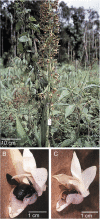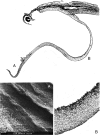Pollination biology of Eulophia alta (Orchidaceae) in Amazonia: effects of pollinator composition on reproductive success in different populations
- PMID: 19666899
- PMCID: PMC2749546
- DOI: 10.1093/aob/mcp191
Pollination biology of Eulophia alta (Orchidaceae) in Amazonia: effects of pollinator composition on reproductive success in different populations
Abstract
Background and aims: Spatial variation in pollinator composition and abundance is a well-recognized phenomenon. However, a weakness of many studies claiming specificity of plant-pollinator interactions is that they are often restricted to a single locality. The aim of the present study was to investigate pollinator effectiveness of the different flower visitors to the terrestrial orchid Eulophia alta at three different localities and to analyse whether differences in pollinator abundance and composition effect this plant's reproductive success.
Methods: Natural pollination was observed in vivo, and manipulative experiments were used to study the pollination biology and breeding system of E. alta at three sites near Manaus, Brazil. To gain a better understanding of the underlying mechanisms of pollinator attraction, nectar composition and secretion patterns were also studied, floral scent composition was analysed and a bioassay was conducted.
Key results: Flower visitors, pollinator composition, pollinia transfer efficiency of particular pollinator species and natural fruit set differed among the investigated populations of E. alta. Flowers were self-compatible, partially autogamous and effectively pollinated by five bee species (four Centris species and Xylocopa muscaria). Visiting insects appeared to imbibe small amounts of hexose-rich nectar. Nectar sugar content was highest on the third day after flower opening. Floral fragrance analyses revealed 42 compounds, of which monoterpenes and benzenoids predominated. A bioassay using floral parts revealed that only floral tissue from the labellum chamber and labellum tip was attractive to flower visitors.
Conclusions: The data suggest that observed differences in reproductive success in the three populations cannot be explained by absolute abundance of pollinators alone. Due to behavioural patterns such as disturbance of effective pollinators on flowers by male Centris varia bees defending territory, pollinia transfer efficiencies of particular pollinator species also vary between study sites and result in differing reproductive success.
Figures




References
-
- Ackerman JD. Mechanisms and evolution of food-deceptive pollination systems in orchids. Lindleyana. 1986;1:108–113.
-
- Ackerman JD, Rodriguez-Robles JA, Meléndez EJ. A meager nectar-offering by an epiphytic orchid is better than nothing. Biotropica. 1994;26:44–49.
-
- Ackerman JD, Meléndez-Ackerman EJ, Salguero-Faria J. Variation in pollinator abundance and selection on fragrance phenotypes in an epiphytic orchid. American Journal of Botany. 1997;84:1383–1390. - PubMed
-
- Aigner PA. Optimality modeling and fitness trade-off: when should plants become pollinator specialists? Oikos. 2001;95:177–184.
-
- Aizen MA, Feinsinger P. Forest fragmentation, pollination, and plant reproduction in a chaco dry forest, Argentina. Ecology. 1994;75:320–341.

